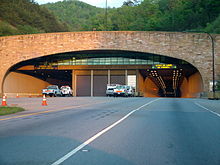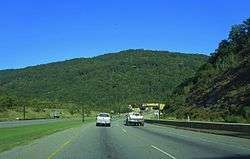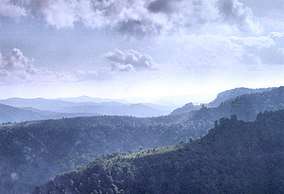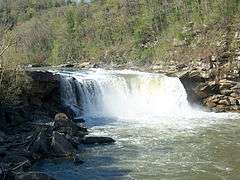Cumberland Gap Tunnel
The Cumberland Gap Tunnel is a tunnel that carries U.S. Route 25E under Cumberland Gap National Historical Park near the intersection of Kentucky, Tennessee, and Virginia. According to United States Geological Survey maps of the area, the tunnel does not enter Virginia. It is one of only two mountain vehicular tunnels in the United States that cross a state line, the other being the East River Mountain Tunnel on Interstate 77 and U.S. Route 52 between Virginia and West Virginia.
 | |
| Overview | |
|---|---|
| Location | Tennessee-Kentucky state line underneath Cumberland Gap |
| Coordinates | 36°35′53″N 83°40′34″W |
| Route | |
| Start | Cumberland Gap, Tennessee |
| End | Middlesboro, Kentucky |
| Operation | |
| Opened | October 18, 1996 |
| Toll | none, cost $280M |
| Technical | |
| Length | 0.9 miles (1.4 km) |
| No. of lanes | 4 |
| Tunnel clearance | 30 ft (9.14 m) |

Overview
The tunnels consist of two tubes, each 4,600 feet (1,402 m) long. Each tube carries two lanes of traffic. An "illumination zone" is included at each portal to allow drivers' vision to adjust to the lower light level in the tunnel. The speed limit in the tunnel is 45 mph (70 km/h); lane changes are prohibited. Trucks carrying Class 1 hazardous cargo (i.e., explosives) are prohibited from using the tunnels, while other hazardous cargo and wide loads are directed to a pull-off area and sent through one at a time with an escort. The overall construction cost, including the four-lane approach roads at both portals, was $280 million.
The tunnel replaced a 2.3-mile (3.7 km) stretch of U.S. 25E between Middlesboro, Kentucky and Cumberland Gap, Tennessee that became known as "Massacre Mountain" due to the large number of travelers killed on the twisting mountain road over the Cumberland Gap pass.
Project history
Even in the late 1970s, road traffic through the park had increased to the point of being unmanageable, and the project to replace the surface road began in 1980. However, construction did not begin until 1991. Early on, it was decided that widening the existing surface road to four lanes would adversely affect the historically sensitive areas in the park, making a tunnel the only viable choice. As a part of the plan, the existing road through Cumberland Gap has been removed and restored as a wagon path similar to that used by early 19th-century travelers.
Construction was administered by the Eastern Federal Lands Highway Division of the Federal Highway Administration for the National Park Service, with funding provided by both agencies as well as the states of Kentucky and Tennessee. While the project was in the planning phases, Kentucky and Tennessee both began widening their portions of U.S. 25E leading to Cumberland Gap to four lanes. Construction inspection, project management and engineering services were administered by Vaughn & Melton Consulting Engineers.
The first step in construction was the boring of a pilot tunnel underneath the mountain, which revealed some unexpected construction challenges. The boring revealed underground springs and streams that would result in leakage of 450 gallons (1,700 L) per minute of water into the tunnel, regardless of outside weather conditions. To eliminate leakage into the tunnel, the tubes were lined with a thick PVC layer.
Construction of the actual tubes began on June 21, 1991. Excavation continued simultaneously from both sides, and the tunnels were joined on July 9, 1992. The tunnels opened to traffic on October 18, 1996. The southbound tunnel was briefly closed in 2006-2007 for construction.
In 2012, the tunnel was partially closed to replace some of the crushed limestone road base with granite.



